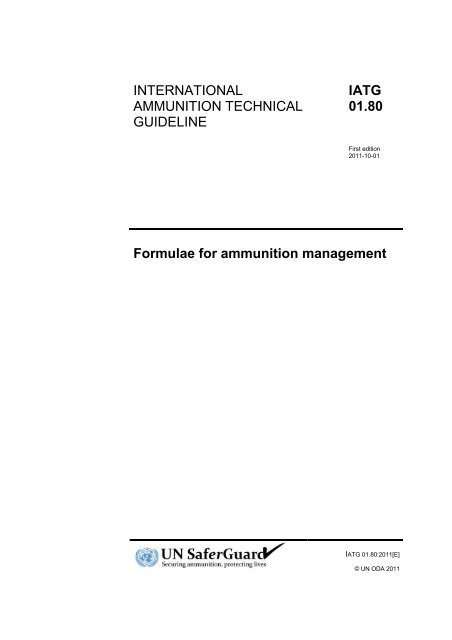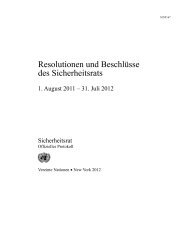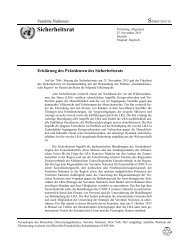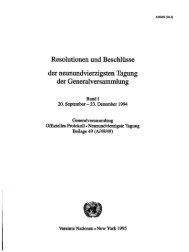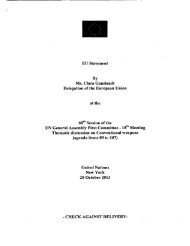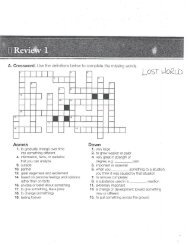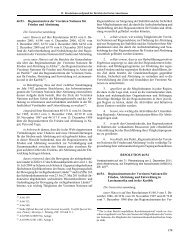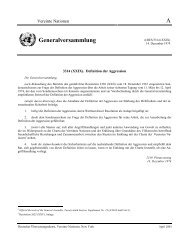IATG 01.80
IATG 01.80
IATG 01.80
You also want an ePaper? Increase the reach of your titles
YUMPU automatically turns print PDFs into web optimized ePapers that Google loves.
INTERNATIONAL<br />
AMMUNITION TECHNICAL<br />
GUIDELINE<br />
<strong>IATG</strong><br />
<strong>01.80</strong><br />
First edition<br />
2011-10-01<br />
Formulae for ammunition management<br />
<strong>IATG</strong> <strong>01.80</strong>:2011[E]<br />
© UN ODA 2011
Warning<br />
i<br />
<strong>IATG</strong> <strong>01.80</strong>:2011[E]<br />
1st Edition (2011-10-01)<br />
The International Ammunition Technical Guidelines (<strong>IATG</strong>) are subject to regular review and<br />
revision. This document is current with effect from the date shown on the cover page. To<br />
verify its status, users should consult the UN SaferGuard <strong>IATG</strong> project through the United<br />
Nations Office for Disarmament Affairs (UNODA) website at<br />
www.un.org/disarmament/convarms/Ammunition.<br />
Copyright notice<br />
This document is an International Ammunition Technical Guideline and is copyright protected<br />
by the United Nations. Neither this document, nor any extract from it, may be reproduced,<br />
stored or transmitted in any form, or by any means, for any other purpose without prior<br />
written permission from UNODA, acting on behalf of the United Nations.<br />
This document is not to be sold.<br />
United Nations Office for Disarmament Affairs (UNODA)<br />
United Nations Headquarters, New York, NY 10017, USA<br />
E-mail: conventionalarms-unoda@un.org<br />
Fax: +1 212 963 8892<br />
© UN 2011 – All rights reserved
Contents<br />
ii<br />
<strong>IATG</strong> <strong>01.80</strong>:2011[E]<br />
1st Edition (2011-10-01)<br />
Contents.................................................................................................................................................. ii<br />
Foreword ................................................................................................................................................ iv<br />
Introduction ............................................................................................................................................. v<br />
Formulae for ammunition management..................................................................................................1<br />
1 Scope................................................................................................................................................1<br />
2 Normative references .......................................................................................................................1<br />
3 Terms and definitions .......................................................................................................................1<br />
4 Background.......................................................................................................................................2<br />
5 Hopkinson-Cranz scaling law ...........................................................................................................2<br />
6 Air blast.............................................................................................................................................3<br />
6.1 Rankine-Hugoniot (shock front parameters) ................................................................................................. 3<br />
6.1.1. Shock front velocity...................................................................................................................................................... 3<br />
6.1.2. Particle velocity............................................................................................................................................................ 3<br />
6.1.3. Air density behind the shock front ................................................................................................................................ 4<br />
6.1.4. Dynamic pressure........................................................................................................................................................ 4<br />
6.1.5. Reflected pressure....................................................................................................................................................... 4<br />
6.2 Kingery and Bulmash.................................................................................................................................... 4<br />
6.2.1. Incident Pressure......................................................................................................................................................... 5<br />
6.2.2. Incident Impulse........................................................................................................................................................... 5<br />
6.2.3. Reflected Pressure ...................................................................................................................................................... 5<br />
6.2.4. Reflected Impulse ........................................................................................................................................................ 6<br />
6.3 Sachs scaling law ......................................................................................................................................... 6<br />
6.4 Reflection coefficient..................................................................................................................................... 6<br />
6.5 Impulse ......................................................................................................................................................... 7<br />
6.5.1. General impulse........................................................................................................................................................... 7<br />
6.5.2. Scaled impulse ............................................................................................................................................................ 7<br />
7 Explosive parameters .......................................................................................................................7<br />
7.1 Detonation pressure...................................................................................................................................... 7<br />
7.2 TNT equivalence........................................................................................................................................... 7<br />
8 Ballistics............................................................................................................................................8<br />
8.1 Gurney .......................................................................................................................................................... 8<br />
8.2 Simple fragment range estimation ................................................................................................................ 9<br />
9 Simple range safety distances..........................................................................................................9<br />
9.1 Basic equations............................................................................................................................................. 9<br />
9.2 Basic equations (alternative)....................................................................................................................... 10<br />
9.3 Vertical danger areas.................................................................................................................................. 10<br />
9.4 Simple noise prediction............................................................................................................................... 11<br />
10 Effects on structures.....................................................................................................................11<br />
10.1 Air blast..................................................................................................................................................... 11<br />
10.2 Fragmentation........................................................................................................................................... 12
iii<br />
<strong>IATG</strong> <strong>01.80</strong>:2011[E]<br />
1st Edition (2011-10-01)<br />
10.3 Ground shock............................................................................................................................................ 12<br />
11 Effects on people..........................................................................................................................13<br />
11.1 Individual risk ............................................................................................................................................ 13<br />
11.2 Primary blast injury levels ......................................................................................................................... 14<br />
11.3 Secondary blast injury levels..................................................................................................................... 14<br />
12 Underground storage....................................................................................................................15<br />
Annex A (normative) References..........................................................................................................16<br />
Annex B (informative) References........................................................................................................17
Foreword<br />
iv<br />
<strong>IATG</strong> <strong>01.80</strong>:2011[E]<br />
1st Edition (2011-10-01)<br />
In 2008, a United Nations group of governmental experts reported to the General Assembly on<br />
problems arising from the accumulation of conventional ammunition stockpiles in surplus. 1 The<br />
group noted that cooperation with regard to effective stockpile management needs to endorse a<br />
‘whole life management’ approach, ranging from categorisation and accounting systems – essential<br />
for ensuring safe handling and storage and for identifying surplus – to physical security systems,<br />
and including surveillance and testing procedures to assess the stability and reliability of<br />
ammunition.<br />
A central recommendation made by the group was for technical guidelines for the stockpile<br />
management of ammunition to be developed within the United Nations.<br />
Subsequently, the General Assembly welcomed the report of the group and strongly encouraged<br />
States to implement its recommendations. 2 This provided the mandate to the United Nations for<br />
developing ‘technical guidelines for the stockpile management of conventional ammunition’, now<br />
commonly known as International Ammunition Technical Guidelines (<strong>IATG</strong>).<br />
The work of preparing, reviewing and revising these guidelines was conducted under the United<br />
Nations SaferGuard Programme by a technical review panel consisting of experts from Member<br />
States, with the support of international, governmental and non-governmental organisations. The<br />
latest version of each guideline, together with information on the work of the technical review panel,<br />
can be found at www.un.org/disarmament/convarms/Ammunition.<br />
These <strong>IATG</strong> will be regularly reviewed to reflect developing ammunition stockpile management<br />
norms and practices, and to incorporate changes due to amendments to appropriate international<br />
regulations and requirements.<br />
1 UN General Assembly A/63/182, Problems arising from the accumulation of conventional ammunition stockpiles in surplus.<br />
28 July 2008. (Report of the Group of Governmental Experts). The Group was mandated by A/RES/61/72, Problems arising<br />
from the accumulation of conventional ammunition stockpiles in surplus. 6 December 2006.<br />
2 UN General Assembly (UNGA) Resolution A/RES/63/61, Problems arising from the accumulation of conventional<br />
ammunition stockpiles in surplus. 2 December 2008.
Introduction<br />
v<br />
<strong>IATG</strong> <strong>01.80</strong>:2011[E]<br />
1st Edition (2011-10-01)<br />
The nature of ammunition and explosives with their potential for unplanned, violent reaction makes<br />
it necessary to develop recommendations and guidelines for safe conventional ammunition<br />
management stockpile management. This requires, by necessity, a risk-based approach 3 , which<br />
should be based on sound explosive engineering and science.<br />
Risk management decisions based on more complete knowledge can be made if the likelihood of<br />
an explosives accident can be taken into account as well as the consequences. This requires<br />
knowledge of the range of scientifically accepted formulae that can be used to support decisionmaking<br />
and risk management during conventional ammunition stockpile management.<br />
This <strong>IATG</strong> summarise the scientific formulae that are either useful or essential to safe, effective and<br />
efficient stockpile management. Their detailed use is explained in the other topic-specific <strong>IATG</strong> in<br />
the remainder of the guidelines or in the accompanying <strong>IATG</strong> software.<br />
3 <strong>IATG</strong> 02.10 Introduction to Risk Management Principles and Processes contains further information on risk-based<br />
approaches to conventional ammunition stockpile management.
1 Scope<br />
Formulae for ammunition management<br />
1<br />
<strong>IATG</strong> <strong>01.80</strong>:2011[E]<br />
1st Edition (2011-10-01)<br />
This <strong>IATG</strong> introduces and summarises scientifically proven and sound formulae that may be used<br />
to support the decision-making and risk management processes essential for the safe and effective<br />
stockpile management of conventional ammunition. 4 Guidance on their appropriate use is either<br />
contained within this <strong>IATG</strong>, the complementary <strong>IATG</strong> software or in other more specific technical<br />
<strong>IATG</strong>. They are summarised here for ease of reference in their use later.<br />
2 Normative references<br />
The following referenced documents are indispensable for the application of this document. For<br />
dated references, only the edition cited applies. For undated references, the latest edition of the<br />
referenced document (including any amendments) applies.<br />
A list of normative references is given in Annex A. Normative references are important documents<br />
to which reference is made in this guide and which form part of the provisions of this guide.<br />
A further list of informative references is given at Annex B in the form of a bibliography, which lists<br />
additional documents that contain other useful information on formulae for the stockpile<br />
management of conventional ammunition.<br />
3 Terms and definitions<br />
For the purposes of this guide the following terms and definitions, as well as the more<br />
comprehensive list given in <strong>IATG</strong> 01.40:2011(E) Terms, definitions and abbreviations, shall apply.<br />
The term ‘brisance’ refers to the shattering effect or power of an explosion or explosive.<br />
The term ‘hazard’ refers to a potential source of harm.<br />
The term ‘quantity distance’ refers to the designated safe distance between a potential explosion<br />
site and an exposed site.<br />
The term ‘risk’ refers to a combination of the probability of occurrence of harm and the severity of<br />
that harm.<br />
The term ‘risk management’ refers to the complete risk-based decision-making process.<br />
In all modules of the International Ammunition Technical Guidelines, the words 'shall', 'should',<br />
'may' and 'can' are used to express provisions in accordance with their usage in ISO standards.<br />
a) 'shall' indicates a requirement: It is used to indicate requirements strictly to be followed in<br />
order to conform to the document and from which no deviation is permitted.<br />
b) 'should' indicates a recommendation: It is used to indicate that among several<br />
possibilities one is recommended as particularly suitable, without mentioning or excluding<br />
others, or that a certain course of action is preferred but not necessarily required, or that (in<br />
the negative form, 'should not') a certain possibility or course of action is deprecated but not<br />
prohibited.<br />
c) 'may' indicates permission: It is used to indicate a course of action permissible within the<br />
limits of the document.<br />
4 The detailed use of the formulae is explained in the other topic specific <strong>IATG</strong> in the remainder of the guidelines.
2<br />
<strong>IATG</strong> <strong>01.80</strong>:2011[E]<br />
1st Edition (2011-10-01)<br />
d) ‘can’ indicates possibility and capability: It is used for statements of possibility and<br />
capability, whether material, physical or casual.<br />
4 Background<br />
Ammunition and explosives, by their very nature, present an inherent risk during storage and, if not<br />
managed correctly, a latent hazard to local communities in their vicinity. Undesirable explosive<br />
events regularly occur in ammunition storage areas globally, yet much of the resultant negative<br />
impact on local communities would have been preventable if effective risk management systems<br />
had been developed and implemented.<br />
The use of proven and sound explosive science and engineering is therefore essential in<br />
supporting the risk management processes necessary to achieve safe and efficient conventional<br />
ammunition stockpile management.<br />
This <strong>IATG</strong> contains formulae that should be used to support risk management processes within<br />
conventional ammunition stockpile management and summarises their potential use. More<br />
detailed information on the use of each formula is contained within the topic specific <strong>IATG</strong> in the<br />
remainder of the guidelines.<br />
5 Hopkinson-Cranz scaling law<br />
Many States use rules based upon the explosives, their quantity, and the distance from the<br />
explosive to where people are at risk. These rules are known as Quantity-Distance (Q-D) criteria,<br />
and are based on the approach derived from the Hopkinson-Cranz Scaling Law 5 6 , which is further<br />
amended by a range of coefficients. It is the basis of much of the work on the estimation of<br />
appropriate quantity and separation distances.<br />
NOTE 1 It is not always possible to provide the separation distances called for by Q-D, which are worst case, and an<br />
alternative risk analysis system of quantitative risk assessment (QRA) may be used. (See <strong>IATG</strong> 02.20<br />
Quantity and separation distances for detailed information).<br />
The Hopkinson-Cranz Scaling Law is also referred to as the Cube Root Scaling Law:<br />
(R1/R2) = (W1/W2) 1/3<br />
R = Z.W 1/3<br />
Table 1: Hopkinson-Cranz Scaling Law<br />
R = Range (m)<br />
Z = Constant of Proportionality (dependent on acceptable<br />
blast overpressure)<br />
W = Explosive Weight (kg)<br />
Examples of the constant ‘Z’ used in explosive storage safety 7 are shown in Table 2:<br />
Z Purpose Remarks<br />
8.0<br />
14.8<br />
Used to predict separation distances between<br />
ammunition process buildings (APB) within an<br />
explosive storage area (ESA).<br />
Used to predict separation distances between an<br />
explosive storehouse (ESH) and a public traffic route<br />
with civilian access.<br />
� Additionally minimum safe<br />
distances further apply if R is<br />
below a certain level, which<br />
differs for each ‘Z’ function.<br />
5 Hopkinson B, UK Ordnance Board Minutes 13565, 1915.<br />
6 Cranz C, Lehrbuch der Ballistik, Springer-Verlag, Berlin, 1916.<br />
7 These are the default ‘Z’ settings in the <strong>IATG</strong> Software, although the software does allow the user to input alternative ‘Z’<br />
values.
3<br />
<strong>IATG</strong> <strong>01.80</strong>:2011[E]<br />
1st Edition (2011-10-01)<br />
Z Purpose Remarks<br />
22.2<br />
44.4<br />
Used to predict separation distances between an<br />
explosive storehouse (ESH) and a building inhabited by<br />
civilians.<br />
Used to predict separation distances between an<br />
explosive storehouse (ESH) and a vulnerable building<br />
inhabited by civilians (e.g. a school).<br />
Table 2: Examples of Constant ‘Z’<br />
Further details on the practical use of this formula are contained within <strong>IATG</strong> 02.20 Quantity and<br />
separation distances.<br />
6 Air blast<br />
The characteristic parameters of a blast wave with a sudden pressure discontinuity at the shock<br />
front are as follows:<br />
a) over-pressure;<br />
b) dynamic pressure;<br />
c) reflected pressure;<br />
d) density;<br />
e) shock front velocity; and<br />
f) particle velocity.<br />
These parameters can be derived using the Rankine-Hugoniot equations. 8<br />
6.1 Rankine-Hugoniot (shock front parameters) 9<br />
6.1.1. Shock front velocity<br />
Vsf = c . (1 + (6Ps/7P0)) 1/2<br />
6.1.2. Particle velocity<br />
Vp = (5Ps/7P0). (c/(1 + (6 Ps . 7P0)) 1/2 )<br />
Table 3: Shock front velocity<br />
Table 4: Particle velocity<br />
Vsf = Shock Front Velocity (m/s)<br />
c = Speed of Sound (m/s)<br />
Ps = Peak Side-On Pressure (kPa)<br />
P0 = Ambient Pressure (kPa)<br />
Vp = Particle Velocity (m/s)<br />
Ps = Peak Side-On Pressure (kPa)<br />
P0 = Ambient Pressure (kPa)<br />
c = Speed of Sound (m/s)<br />
8 Rankine W J H. The Dynamics of Explosion and its Use. Elsevier. Amsterdam. 1979.<br />
9 The Rankine-Hugoniot equations are only applicable under the condition that the particle velocity ahead of the shock front<br />
is zero and that the air behaves as an ideal gas (with a specific heat ratio of 1.4)
6.1.3. Air density behind the shock front<br />
Dsf = (7 + (6 Ps /7P0)/( 7 + Ps/7P0)) . Dair<br />
6.1.4. Dynamic pressure<br />
Table 5: Air density behind the shock front<br />
4<br />
Dsf = Air Density behind Shock Front (kg/m 3 )<br />
Ps = Peak Side-On Pressure (kPa)<br />
P0 = Ambient Pressure (kPa)<br />
Dair = Air Density<br />
<strong>IATG</strong> <strong>01.80</strong>:2011[E]<br />
1st Edition (2011-10-01)<br />
The dynamic pressure during blast loading of a structure is a function of the pressure over time, as<br />
opposed to quasi-static blast loading at a given moment of time:<br />
2<br />
Pd = 5Ps + 2(Ps + 7P0)<br />
6.1.5. Reflected pressure 10<br />
Pr = 2Ps . ((7P0 + 4Ps)/(7P0 = Ps))<br />
Table 6: Dynamic pressure<br />
Table 7: Reflected pressure<br />
Pd = Peak Dynamic Pressure (kPa)<br />
Ps = Peak Side-On Pressure (kPa)<br />
P0 = Ambient Pressure (kPa)<br />
Pr = Peak Reflected Pressure (kPa)<br />
P0 = Ambient Pressure (kPa)<br />
Ps = Peak Side-On Pressure (kPa)<br />
Further details on the practical use of these formulae are contained within <strong>IATG</strong> 02.20 Quantity and<br />
separation distances or the Explosion Consequence Analysis concept in <strong>IATG</strong> 02.10 Introduction to<br />
risk management processes and the accompanying <strong>IATG</strong> software.<br />
6.2 Kingery and Bulmash<br />
Equations to estimate blast over-pressure at range have been developed by Charles Kingery and<br />
Gerald Bulmash. These equations are widely accepted as engineering predictions for determining<br />
free-field pressures and loads on structures and form the basis of the US Conventional Weapons<br />
Effects Programme (CONWEP) software. Their report 11 contains a compilation of data from<br />
explosive tests using charge weights from less than 1kg to over 400,000kg. The authors used<br />
curve-fitting techniques to represent the data with high-order polynomial equations, which are<br />
included in the accompanying software to the <strong>IATG</strong> for ease of application.<br />
The equations are summarised in Tables 8 – 13 for information, where functions to represent the<br />
air blast parameters versus distance in metres for a 1kg TNT spherical free-air burst are shown for:<br />
1) Incident Pressure; 2) Incident Impulse; 3) Reflected Pressure; and 4) Reflected Impulse.<br />
The numerical values for the constants ‘C’ and ‘K’ are those for a 1kg TNT equivalent charge.<br />
Predictions for other explosives will require that the TNT equivalence be first estimated (Clause<br />
7.2).<br />
10 Normally reflected pressure.<br />
11 Charles N Kingery and Gerald Bulmash. Airblast Parameters from TNT Spherical Air Burst and Hemispherical Surface<br />
Burst, US Technical Report ARBRL-TR-02555. Ballistics Research Laboratory, Aberdeen Proving Ground, Maryland, USA.<br />
April 1984.
Y = C0 + C1U + C2U + C3U ............CnU<br />
6.2.1. Incident Pressure<br />
Table 8: Kingery and Bulmash general polynomial form<br />
This equation has a range of applicability from 0.05 – 40m.<br />
U = -0.214362789151 + 1.35034249993T<br />
Then substitute U into<br />
Y = 2.611368669 - 1.69012801396U +<br />
0.00804973591951U2 + 0.336743114941U3 -<br />
0.00516226351334U4 - 0.08092286198R8U5 -<br />
0.00478507266747U6 + 0.00793030472242U7 +<br />
6.2.2. Incident Impulse<br />
0.0007684469735UR<br />
Table 9: Kingery and Bulmash polynomial for Incident Pressure<br />
5<br />
<strong>IATG</strong> <strong>01.80</strong>:2011[E]<br />
1st Edition (2011-10-01)<br />
Y = Common Logarithm of the Air Blast<br />
Parameter (metric) (Pressure or Impulse)<br />
C0,1 ,2 etc = Constant<br />
U = K0 + K1T<br />
K0, 1 etc = Constant<br />
T = Common Logarithm of the Distance (m)<br />
U = K0 + K1T<br />
T = Common Logarithm of the Distance (m)<br />
Y = Common Logarithm of the Air Blast<br />
Parameter (metric) (Pressure or Impulse)<br />
The equation at Table 10 is only applicable for the near field range of 0.0531m, in other words<br />
immediately next to the explosive charge.<br />
U = 2.34723921354 + 3.24299066475T<br />
Then substitute U into<br />
Y = 2.38830516757 - 0.443749377691U +<br />
0.168825414684U2 + 0.0348138030308U3 -<br />
0.010435192824U4<br />
U = K0 + K1T<br />
T = Common Logarithm of the Distance (m)<br />
Y = Common Logarithm of the Air Blast<br />
Parameter (metric) (Pressure or Impulse)<br />
Table 10: Kingery and Bulmash polynomial for Incident Impulse (very near field)<br />
The equation at Table 11 is applicable for ranges as the blast wave moves away from the explosive<br />
charge (0.792 – 40.0m).<br />
U = -1.75305660315 + 0.30629231803T<br />
Then substitute U into<br />
Y = 1.55197227115 - 0.40463292088U -<br />
0.0142721946082U2 + 0.00912366316617U3 -<br />
0.0006750681404U4 - 0.0080086371B901U5 =<br />
0.00314819515931U6 + 0.00152044783382U7 -<br />
0.0007470265899U8<br />
6.2.3. Reflected Pressure<br />
Table 11: Kingery and Bulmash polynomial for Incident Impulse<br />
This equation has a range of applicability from 0.05 – 40m.<br />
U = K0 + K1T<br />
T = Common Logarithm of the Distance (m)<br />
Y = Common Logarithm of the Air Blast<br />
Parameter (metric) (Pressure or Impulse)
U = -0.214362789151 + 1.35034249993T<br />
Then substitute U into<br />
Y = 3.22958031387 - 2.21400538997U +<br />
0.035119031446U2 + 0.657599992109U3 +<br />
0.0141818951887U4 - 0.243076636231U5 -<br />
0.0158699803158U6 + 0.0492741184234U7 +<br />
0.00227639644004U8 - 0.00397126276058U9<br />
6.2.4. Reflected Impulse<br />
Table 12: Kingery and Bulmash polynomial for Reflected Pressure<br />
This equation has a range of applicability from 0.05 – 40m.<br />
U = 0.204004553231 + 1.37882996018T<br />
Then substitute U into<br />
Y = 2.55875660396 - 0.903118886091U +<br />
0.101771877942U2 - 0.0242139751146U3<br />
Table 13: Kingery and Bulmash polynomial for Reflected Impulse<br />
6<br />
<strong>IATG</strong> <strong>01.80</strong>:2011[E]<br />
1st Edition (2011-10-01)<br />
U = K0 + K1T<br />
T = Common Logarithm of the Distance (m)<br />
Y = Common Logarithm of the Air Blast<br />
Parameter (metric) (Pressure or Impulse)<br />
U = K0 + K1T<br />
T = Common Logarithm of the Distance (m)<br />
Y = Common Logarithm of the Air Blast<br />
Parameter (metric) (Pressure or Impulse)<br />
Further details on the practical use of these formulae are contained within the Explosion<br />
Consequence Analysis concept in <strong>IATG</strong> 02.10 Introduction to risk management processes and the<br />
accompanying <strong>IATG</strong> software.<br />
6.3 Sachs scaling law<br />
In the case of blast waves from explosions produced at altitude, where ambient conditions can be<br />
very different from those at sea level, the most commonly used scaling law is that due to Sachs. 12<br />
The application of the Sachs scaling law leads to the formulation of altitude scaling factors.<br />
Scaled Distance at Altitude ‘z’<br />
Sdz = (P0/Pz) 1/3<br />
Scaled Pressure at Altitude ‘z’<br />
Spz = (Pz/P0)<br />
Scaled Impulse at Altitude ‘z’<br />
Siz = (Pz/P0) 2/3 . (T0/Tz) 1/2<br />
Scaled Impulse at Altitude ‘z’<br />
St = (P0/Pz) 1/3 . (T0/Tz) 1/2<br />
6.4 Reflection coefficient<br />
Table 14: Sachs scaling factors<br />
Sdz = Scaled Distance at Altitude ‘z’ (m)<br />
P0 = Ambient Pressure (kPa) (101.33kPa)<br />
Pz = Pressure at Altitude ‘z’ (kPa)<br />
Spz = Scaled Pressure at Altitude ‘z’ (kPa)<br />
Siz = Scaled Impulse at Altitude ‘z’ (kg.m/s)<br />
T0 = Ambient Temperature (K) (288.16 0 K)<br />
Tz = Temperature at Altitude ‘z’ (K)<br />
St = Scaled Times at Altitude ‘z’ (s)<br />
The Reflection Coefficient is used during explosion consequence analysis (ECA) to compare Peak<br />
Reflected Pressure against Peak Side-On Pressure:<br />
12 Sachs R G. The dependence of Blast on Ambient Pressure and Temperature. Technical Report 466. Ballistics Research<br />
Laboratory, Aberdeen Proving Ground, Maryland, USA. May 1944.
6.5 Impulse<br />
Cr = Pr / Ps<br />
6.5.1. General impulse<br />
7<br />
Cr = Reflection Coefficient<br />
Table 15: Reflection Coefficient<br />
Pr = Peak Reflected Pressure (kPa)<br />
Ps = Peak Side-On Pressure (kPa)<br />
<strong>IATG</strong> <strong>01.80</strong>:2011[E]<br />
1st Edition (2011-10-01)<br />
The decisive parameter for the damage caused by air blast is the positive overpressure impulse. It<br />
should be determined by integration of the positive over-pressure phase, (i.e. defined by the total<br />
area below the pressure-time curve).<br />
Is = ʃ Ps . t. dt<br />
6.5.2. Scaled impulse<br />
Table 16: General Impulse<br />
Is = Side-On Impulse (kg.m/s)<br />
Ps = Peak Side-On Pressure (kPa)<br />
t = Time (s)<br />
The scaled impulse is often used to predict the effects of blast on humans:<br />
1/2 1/3<br />
Isi = Is / P0 . m<br />
7 Explosive parameters<br />
7.1 Detonation pressure<br />
Isi = Scaled Impulse (kg.m/s)<br />
Is = Side-On Impulse (kg.m/s)<br />
P0 = Ambient Pressure (kPa)<br />
M = Mass of Individual (kg)<br />
Table 17: Scaled Impulse on Individuals<br />
The Detonation Pressure of an explosive provides an indicator of its ability to do work and<br />
determines whether it is a high brisance or low brisance explosive. It can be approximated as<br />
shown in Table 18:<br />
Pdet = 2.5 . Vd . (D/0.0000001)<br />
7.2 TNT equivalence<br />
Table 18: Detonation Pressure<br />
Pdet = Detonation Pressure (GPa)<br />
Vd = Velocity of Detonation of Explosive (m/s)<br />
D = Density (g/cm 3 )<br />
The majority of air blast and impulse equations predict for TNT, and it is therefore desirable to<br />
convert the explosive mass into equivalent TNT charge mass.
MTNTe = (E d<br />
exp/E d<br />
TNT) . Mexp<br />
Table 19: TNT Equivalence<br />
8<br />
<strong>IATG</strong> <strong>01.80</strong>:2011[E]<br />
1st Edition (2011-10-01)<br />
MTNTe = TNT Equivalent Mass (kg)<br />
E d exp = Specific Detonation Energy of Explosive (J/kg)<br />
E d TNT) = Specific Detonation Energy of TNT (J/kg)<br />
Mexp = Mass of Explosive (kg)<br />
Table 20 contains pre-calculated TNT equivalence factors for a range of high explosives. These<br />
are accurate enough for design purposes.<br />
Explosive<br />
TNT Equivalent Mass<br />
Peak Pressure Impulse<br />
Pressure Range<br />
(MPa)<br />
Composition B 1.11 0.98 0.035 - 0.350<br />
Composition C3 1.08 1.01 0.035 - 0.350<br />
Composition C4 1.37 1.19 0.070 - 0.700<br />
Octol 75/25 1.06 1.06 -<br />
PETN 1.27 - 0.035 - 0.700<br />
RDX 1.14 1.09 -<br />
RDX / TNT 60/40 (Cyclotol) 1.14 1.09 0.035 - 0.350<br />
Tetryl 1.07 - 0.021 - 0.140<br />
TNT 1.00 1.00 Standard<br />
Tritonal 1.07 0.96 0.035 - 0.700<br />
8 Ballistics<br />
8.1 Gurney<br />
Table 20: TNT Equivalence<br />
The Gurney Equations 13 are a range of formulae used in explosives engineering to predict how fast<br />
an explosive will accelerate a surrounding layer of metal or other material when the explosive<br />
detonates. This determines how fast fragments are released on detonation of an item of<br />
ammunition. This initial fragment velocity can then be used with other ballistic equations to predict<br />
either danger areas or fragment penetration.<br />
Cylindrical Charge Equation 14<br />
(V/√2E) = ((M/Cexp) + ½)) -1/2<br />
Spherical Charge Equation 15<br />
(V/√2E) = ((M/Cexp) + 3/5)) -1/2<br />
Table 21: Gurney Equations 17<br />
V = Initial Fragment Velocity (m/s)<br />
√2E = Gurney Constant for a given explosive (m/s)<br />
M = Mass of Fragment (kg) 16<br />
Cexp = Explosive Charge Mass (kg)<br />
13<br />
Gurney, R. W. The Initial Velocities of Fragments from Bombs, Shells, and Grenades, BRL-405. Ballistic Research<br />
Laboratory, Aberdeen, Maryland. USA. 1943.<br />
14<br />
First order approximation for most high explosive artillery shells, mortar bombs and missile warheads.<br />
15<br />
Use for military grenades and some cluster bomblets.<br />
16<br />
For an artillery shell this is usually the base for which an estimate of mass is made from the total body mass.<br />
17<br />
There are other Gurney equations for symmetrical, asymmetrical, open faced and infinitely tamped sandwiches. These<br />
are beyond the scope of this <strong>IATG</strong> and have hence been excluded.
9<br />
<strong>IATG</strong> <strong>01.80</strong>:2011[E]<br />
1st Edition (2011-10-01)<br />
The Gurney Constant √2E is usually very close to 1/3 of the Detonation Velocity of the explosive.<br />
Table 22 contains the Gurney Constants for a range of high explosives: 18<br />
Explosive<br />
Density<br />
(kg/m 3 )<br />
Detonation Velocity<br />
(m/s)<br />
Gurney Constant √2E<br />
(m/s)<br />
Amatol 1.71 6,800 1,886<br />
Composition B 1.72 7,920 2,774<br />
Composition C4 1.71 7,800 2,530<br />
HMX 1.71 8,830 2,972<br />
Octol 75/25 1.82 8.480 2,896<br />
PETN 1.71 8,260 2,926<br />
RDX 1.81 8,700 2,926<br />
RDX / TNT 60/40 (Cyclotol) 1.78 8,100 2,402<br />
Tetryl 1.62 7,570 2,499<br />
TNT 1.63 6,860 2,438<br />
Tritonal 1.72 6,700 2,316<br />
Table 22: Gurney Constants<br />
8.2 Simple fragment range estimation 19<br />
A simple equation to predict the range of a fragment is at Table 23, but as it does not reflect any of<br />
the characteristics of the munition, nor account for drag, it should be used with great caution:<br />
R = (V0/g) . Sin 2θ<br />
R = Range (m)<br />
V0 = Initial Fragment Velocity (m/s)<br />
g = Gravity (m/s 2 )<br />
θ = Launch Angle (Radians)<br />
Table 23: Simple Range Prediction<br />
More accurate predictions rely on a range of complex ballistic equations 20 due to the large number<br />
of variables involved. 21 Therefore more detailed range analysis should only be used by qualified<br />
personnel and hence are not discussed further in this <strong>IATG</strong>.<br />
9 Simple range safety distances 22<br />
9.1 Basic equations<br />
The following simple safety distances can be used to estimate range danger areas when planning<br />
the destruction of ammunition by open detonation. They may be used for ‘quick planning’ on<br />
demolition ranges with existing danger areas. If used on demolition areas with no formal danger<br />
18 Densities and detonation velocities are approximate as explosive mixtures vary.<br />
19 See Technical Note for Mine Action (TNMA) 10.20/01 Estimation of Explosion Danger Areas (Version 2.0). Geneva.<br />
GICHD. Further details on their use are available there.<br />
20 Air Drag, Fragment Slow Down, Mott Fragmentation etc.<br />
21 For example: 1) fragment size; 2) fragment shape; 3) material density; 4) initial velocity; 5) drag coefficient; 6) effects of<br />
gravity; 7) ballistic flight stability; 8) target composition etc.<br />
22 These equations are based on work conducted by Mr Pilgrim, AWE Foulness, UK. QInetiQ uses derivatives of these<br />
equations in their trials work. This information was obtained from a UK MOD KGH/Safety Services Organisation paper on<br />
Danger Areas dated 31 July 1990.
10<br />
<strong>IATG</strong> <strong>01.80</strong>:2011[E]<br />
1st Edition (2011-10-01)<br />
areas the user should remember that the distance produced by these equations is that distance<br />
outside which no more than one fragment would be expected to fly. They are NOT absolutely safe.<br />
For fragmenting munitions when public access<br />
is possible to the demolition range area.<br />
D = 634(AUW) 1/6<br />
For fragmenting munitions when public access<br />
is denied to the demolition range area.<br />
D = 444(AUW) 1/6<br />
For bare exposed explosive only.<br />
D = 130(AUW) 1/3<br />
9.2 Basic equations (alternative)<br />
Table 24: Simple Range Safety Distances<br />
D = Distance (m)<br />
AUW = All Up Weight of Ammunition or Bare Explosives<br />
(kg)<br />
The Australian Defence Science and Technology Organisation (DSTO) conducted research in<br />
March 1997 into multi-item demolition of ammunition and explosives. They concluded that<br />
fragmentation explosion danger areas for multi-item demolitions can be reduced to that of the<br />
largest Net Explosive Quantity single munition in the demolition provided. Results from the<br />
equation in Table 25 compare favourably with those for the public access denied equation in Table<br />
24:<br />
a) the ordnance is arranged in a linear array and NOT a stack;<br />
b) the ordnance is detonated simultaneously; and<br />
c) the items are GREATER than one charge diameter apart.<br />
D = 370(AUW) 1/5<br />
9.3 Vertical danger areas<br />
Table 25: Simple Range Safety Distances (Alternative)<br />
D = Distance (m)<br />
AUW = All Up Weight of Ammunition or Bare Explosives<br />
(kg)<br />
The equations to estimate the vertical danger areas necessary to warn air traffic of demolitions<br />
taking place on the ground differ slightly from Clauses 9.1 and 9.2 as no ballistic parabola needs to<br />
be taken into account.<br />
For single ammunition item only.<br />
D = 314(AUW) 1/3<br />
For multi-item fragmenting munitions.<br />
D = 470(AUW) 1/5<br />
Table 26: Vertical danger Areas<br />
D = Distance (m)<br />
AUW = All Up Weight of Ammunition or Bare Explosives<br />
(kg)
9.4 Simple noise prediction<br />
11<br />
<strong>IATG</strong> <strong>01.80</strong>:2011[E]<br />
1st Edition (2011-10-01)<br />
The following equation 23 can be used to predict the distance at which 140dB 24 of sound could be<br />
expected to be achieved:<br />
D = 215 (Mexp) 1/3<br />
10 Effects on structures<br />
Table 27: Simple Noise Prediction<br />
D = Distance (m)<br />
NEQ = Net Explosive Quantity (kg)<br />
The prediction of weapons effects on structures is a complex undertaking due to the large number<br />
of variables involved 25 and the impact that these variables have on structural response to blast<br />
loading.<br />
10.1 Air blast<br />
Rough estimates for structural damage due to air blast may be obtained from empirically derived<br />
models based on an analysis of accidents, trials and war damage data. This analysis correlates<br />
the structural damage with the distance from the explosion and the charge mass involved.<br />
The most extensive data is available for brick-built structures due to studies undertaken in World<br />
War 2. Explosion induced damage categories for brick built housing have been developed 26 which<br />
may be used in explosion consequence analysis to illustrate the potential severity of the effects of<br />
an undesirable explosion:<br />
Category Definition Remarks<br />
A Houses completely demolished. �<br />
B<br />
CB<br />
CA<br />
D<br />
Houses so badly damaged they are<br />
beyond repair and require demolition.<br />
Houses rendered uninhabitable but can<br />
be repaired with extensive work.<br />
Houses rendered uninhabitable but can<br />
be repaired reasonably quickly.<br />
Houses requiring repairs to remedy<br />
serious inconvenience but remain<br />
habitable.<br />
� 50% - 75% of external brickwork destroyed.<br />
� Remaining walls have gaping cracks that are unrepairable.<br />
� Partial or total collapse of roof structure.<br />
� Partial demolition of walls up to 25% of the whole.<br />
� Severe damage to load bearing partitions<br />
necessitating demolition and replacement.<br />
� Does not exceed minor structural damage.<br />
� Partitions and joinery wrenched from fittings.<br />
� Damage to ceilings and tiling.<br />
Table 28: Brick Built Housing Damage Categories<br />
� Minor fragmentation effects on walls and glazing.<br />
The data analysis used to produce Table 28 led to an empirically derived formula to estimate<br />
damage range.<br />
23 Source: QinetiQ Shoeburyness, UK. 1999.<br />
24 The EU maximum permissible noise level for a single event.<br />
25 For example: 1) structure type; 2) structure material strength, elasticity and ductility; 3) structural response to blast<br />
loading; 4) diffraction loading effects; 5) drag loading effects; 6) building orientation to blast loading; 7) local topography etc.<br />
26 Through the work of: 1) Scilly N F and High W G. The blast effect of explosions. Loss prevention and safety promotion 5.<br />
1986; and 2) Jarrett D E. Derivation of the British Explosives Safety Distances. Annals New York Academy of Sciences,<br />
152, Article 1. 1968.
1/3<br />
Rx = (Kx . Mexp ) / ( 1 + (3175/Mexp) 2 ) 1/6<br />
12<br />
Rx = Range for Damage Level ‘x’ (m)<br />
Table 29: Damage Range to Buildings Estimation<br />
<strong>IATG</strong> <strong>01.80</strong>:2011[E]<br />
1st Edition (2011-10-01)<br />
Kx = Constant for Damage Level ‘x’ (See Table 29)<br />
Mexp = Mass of Explosive (kg)<br />
Values for Kx were initially derived by Jarrett and subsequently revised by Gilbert, Lees and<br />
Scilly. 27 The revised values take account of the casing factor, which is the degree of energy<br />
imparted to the primary fragments from the casing, thereby reducing the air blast energy available.<br />
Kx for Damage<br />
Category<br />
Jarrett Gilbert, Lees and Scilly<br />
A 3.8 4.8<br />
B 5.6 7.1<br />
CB 9.6 12.4<br />
CA 28.0 21.3<br />
D 56.0 42.6<br />
10.2 Fragmentation<br />
Table 30: ‘K’ Factors for Table 29<br />
The extent to which fragments will penetrate structures on impact is dependent on a range of<br />
variables, 28 hence leading to very complex expressions for each possible case. These expressions<br />
are empirically derived for specific building materials and fragment combinations. Therefore the<br />
prediction of fragment induced structural damage from hypothetical explosions cannot be easily<br />
predicted without access to a massive range of data. This data is often held by the military and<br />
hence classified.<br />
The example at Table 31 is for the penetration depth of flat-faced cylindrical fragments impacting<br />
on concrete. It may be used in an ECA as an example of damage that could be expected to<br />
modern building structures.<br />
For x/d < 2<br />
x = (2.74 . 10 -5 (((D . d 1/5 )/s 1/2 ) . V 1.8 . 4d 2 )) 1/2<br />
For x/d > 2<br />
x = 2.74 . 10 -5 (((D . d 1/5 )/s 1/2 ) . V 1.8 . d + d)<br />
10.3 Ground shock<br />
x = Fragment Penetration Depth (m)<br />
d = Fragment Diameter (m)<br />
D = Fragment Density (kg/m 3 )<br />
s = Compressive Strength of Concrete (Pa)<br />
V = Fragment Velocity (m/s)<br />
Table 31: Structural Penetration (Concrete v Flat Faced Cylinder)<br />
Ground shock can be understood as a vibration wave travelling through the ground. The wave<br />
takes the form of a sin wave and hence amplitude is a characteristic parameter.<br />
27 Gilbert S M, Lees F P and Scilly N F. A Model Hazard Assessment of the Explosion of an Explosives Vehicle in a Built-<br />
Up Area. Minutes of the 26 th US Department of Defense Explosives Safety Board Seminar. Miami. USA. 1994.<br />
28 For example: 1) building material strength, ductility and elasticity; 2) fragment velocity; 3) fragment shape on impact; 3)<br />
fragment mass; 4) fragment material strength, ductility and elasticity etc.
1/2<br />
A = x . ((K/Mexp )/D))<br />
13<br />
A = Amplitude (m)<br />
x = Constant<br />
Mexp = Mass of Explosive (kg)<br />
K = Constant 29<br />
D = Distance (m)<br />
Table 32: Ground Shock Estimation 30<br />
<strong>IATG</strong> <strong>01.80</strong>:2011[E]<br />
1st Edition (2011-10-01)<br />
Buildings of solid construction are unlikely to be damaged by amplitudes of less than 2 x 10 -4 m<br />
whilst those of a more vulnerable construction should remain undamaged if the amplitude remains<br />
8 x 10 -5m .<br />
A damage index 31 has been developed which relates the mass of explosives and the type of<br />
ground:<br />
ʃ = Mexp/R 3/2<br />
ɸ = Damage Index<br />
Table 33: Damage Index<br />
Mexp = Mass of Explosives (kg)<br />
R = Range (m)<br />
For structures built on soft rock, major cracking damage can be expected to occur at ɸ values of<br />
1.0 kg.m 3/2 whereas for structures built on harder rock the degree of damage may be expected at a<br />
lower ɸ value of 0.25 kg.m 3/2 .<br />
11 Effects on people<br />
There are three modes of blast injury to people: 1) primary; 2) secondary; and 3) tertiary.<br />
a) primary blast injuries are caused by direct action of the blast wave on the body. The most<br />
common injuries are eardrum rupture and lung haemorrhage;<br />
b) secondary blast injuries are those caused as a direct consequence of damage to buildings or<br />
structures. These include blunt trauma, lacerations, suffocation and crushing;<br />
c) tertiary injuries are those caused by body movement induced by the blast wave. These<br />
include internal displacement of body organs or injuries caused by impact when the body is<br />
thrown against hard surfaces.<br />
11.1 Individual risk<br />
Risk is defined as ‘likelihood x consequences’ and, when measured quantitatively, may be used to<br />
support quantitative risk assessments (QRA) where the Individual Risk of Fatality (IR) as a result of<br />
an undesired explosion is compared to ‘tolerable risk’ of other activities or industrial processes.<br />
Therefore the Annual IR can be defined as:<br />
IR = Pe x P f l e x Ep<br />
Pe = Events per Year<br />
Pf I e = Probability of Fatality 32<br />
Ep = Probability of Exposure to Hazard<br />
Table 34: Annual Individual Risk of Fatality (IR)<br />
29 The value of K is inversely proportional to the hardness of the ground.<br />
30 Examples of x and K may be found in Baker W E et al, Explosion Hazards and Evaluation. Elsevier. Amsterdam. 1983.<br />
31 Langefors U and Kihlstrom B. The Modern technique of Rock Blasting. Third Edition. AWE/GERBERS. Sweden. 1978.<br />
32 For a continually exposed person.
11.2 Primary blast injury levels<br />
These should be estimated from:<br />
a) use of Kingary to estimate blast over-pressure at range; and<br />
14<br />
<strong>IATG</strong> <strong>01.80</strong>:2011[E]<br />
1st Edition (2011-10-01)<br />
b) compare blast over-pressure to injury threshold levels derived from Bowen 33 curves,<br />
(34,5kPa for onset of hearing damage, 207kPa for lung damage and 690kPa for fatality).<br />
An alternative methodology is to use the ESTC 34 Outdoor Blast Model, which is based on a review<br />
of available literature on primary and tertiary blast effects. 35<br />
Pfatality = (e (-5.785 . (R / M1/3) +19.047) /100)<br />
Table 35: ESTC Outdoor Blast Model<br />
Pfatality = Probability of Fatality<br />
e = Exponential<br />
R = Range (m)<br />
M 1/3 = Cube Root of Explosive Mass (kg)<br />
The ESTC Model is only valid within the limits of the scaled distance ‘S’ (S = R/M 1/3 ) where 2.5<br />
m.kg 1/3 < S < 5.3 m.kg 1/3 . For S > 5.3 m.kg 1/3 the fatality probability is zero whilst for S < 2.5m.kg 1/3<br />
100% fatalities should be expected.<br />
11.3 Secondary blast injury levels<br />
Gilbert, Lees and Scilly developed probability values for building occupants suffering fatal, serious<br />
or light injuries. These are shown in Table 36. 36<br />
Damage<br />
Category<br />
Damage Definition<br />
Probability<br />
(Fatality)<br />
Probability<br />
(Fatality or<br />
Serious Injury)<br />
Probability<br />
(Fatality, Serious Injury or<br />
Light Injury)<br />
P(K) P (K + I) P (K + SI + LI)<br />
Aa Houses totally demolished. 0.96 1.0 1.0<br />
Ab<br />
Houses almost completely<br />
demolished.<br />
0.57 0.66 0.82<br />
A Houses demolished. 0.62 0.71 0.84<br />
B<br />
Cb<br />
Ca<br />
Houses so badly damaged<br />
they are beyond repair and<br />
require demolition.<br />
Houses rendered<br />
uninhabitable but can be<br />
repaired with extensive work.<br />
Houses rendered<br />
uninhabitable but can be<br />
repaired reasonably quickly.<br />
0.096 0.15 0.38<br />
0.009 0.043 0.13<br />
0 0.002 0.006<br />
33 Bowen. Estimate of Mans Tolerance to the Direct Effects of Air Blast. October 1968.<br />
34 UK Explosive Storage and Transportation Committee.<br />
35 See Chapter 3 to UK Health and Safety Executive, Selection and Use of Explosion Effects and Consequence Models for<br />
Explosives. HSE. UK. 2000.<br />
36 These equate to the damage levels at Table 29, with the addition of Aa for complete demolition and Ab for almost complete<br />
demolition.
Damage<br />
Category<br />
D<br />
Damage Definition<br />
Houses requiring repairs to<br />
remedy serious<br />
inconvenience but remain<br />
habitable.<br />
12 Underground storage<br />
Probability<br />
(Fatality)<br />
15<br />
Probability<br />
(Fatality or<br />
Serious Injury)<br />
<strong>IATG</strong> <strong>01.80</strong>:2011[E]<br />
1st Edition (2011-10-01)<br />
Probability<br />
(Fatality, Serious Injury or<br />
Light Injury)<br />
P(K) P (K + I) P (K + SI + LI)<br />
0 0 0<br />
Table 36: Probability Values for Secondary Blast Injury<br />
<strong>IATG</strong> 02.20 Quantity and separation distances, Annex M contains formulae to be applied for the<br />
estimation or calculation of quantity and separation distances for underground storage. They are<br />
repeated here for completeness of the formulae <strong>IATG</strong>.<br />
IBD = 77 x HD x LD 1/3<br />
HD = 4A/C<br />
LD 1/3 = NEQ<br />
(VCh+ VTunnel)<br />
Where:<br />
HD = Hydraulic Diameter of Tunnel Mouth<br />
LD 1/3 = Loading Density (kg/m 3 )<br />
Where:<br />
A = Cross-sectional Area of Tunnel Entrance (m 2 )<br />
C = Circumference of Tunnel Entrance (m)<br />
VCh= Chamber Volume (m 3 )<br />
VTunnel = Tunnel Volume (m 3 )<br />
37 38<br />
Table 37: Inhabited Building Distance (IBD) (Blast from Tunnel Adit)<br />
D = 27.4 x HD x LD 1/3 As above<br />
Table 38: Process Building Distance (PBD) (Blast from Tunnel Adit)<br />
37 The distance in a non-axial direction may be reduced using a multiplication factor (MF), which should be derived from the<br />
formula MF = 1 / (1 + (θ/56) 2 ) 0.76 , where θ is the angle from the tunnel centre line in degrees.<br />
38 This is a simple approximation. A more accurate methodology is in AASPT-1, Chapter 3, Clause 3.3.4.1 (b) and (c).
Annex A<br />
(normative)<br />
References<br />
16<br />
<strong>IATG</strong> <strong>01.80</strong>:2011[E]<br />
1st Edition (2011-10-01)<br />
The following normative documents contain provisions, which, through reference in this text,<br />
constitute provisions of this part of the guide. For dated references, subsequent amendments to,<br />
or revisions of, any of these publications do not apply. However, parties to agreements based on<br />
this part of the guide are encouraged to investigate the possibility of applying the most recent<br />
editions of the normative documents indicated below. For undated references, the latest edition of<br />
the normative document referred to applies. Members of ISO maintain registers of currently valid<br />
ISO or EN:<br />
a) <strong>IATG</strong> 01.40:2010[E] Terms, glossary and definitions. UNODA. 2010.<br />
The latest version/edition of these references should be used. The UN Office for Disarmament<br />
Affairs (UN ODA) holds copies of all references 39 used in this guide. A register of the latest<br />
version/edition of the International Ammunition Technical Guidelines is maintained by UN ODA,<br />
and can be read on the <strong>IATG</strong> website: www.un.org/disarmament/convarms/Ammunition. National<br />
authorities, employers and other interested bodies and organisations should obtain copies before<br />
commencing conventional ammunition stockpile management programmes.<br />
39 Where copyright permits.
Annex B<br />
(informative)<br />
References<br />
17<br />
<strong>IATG</strong> <strong>01.80</strong>:2011[E]<br />
1st Edition (2011-10-01)<br />
The following informative documents contain provisions, which should also be consulted to provide<br />
further background information to the contents of this guide:<br />
a) Explosion Hazards and Evaluation. W E Baker et al. Elsevier. (ISBN 0 444 42094 0).<br />
Amsterdam. 1983;<br />
b) <strong>IATG</strong> 02.10:2010[E] Introduction to Risk Management Principles and Processes. UNODA.<br />
2010;<br />
c) Selection and Use of Explosion Effects and Consequence Models for Explosives. UK Health<br />
and Safety Executive. (ISBN 0 7176 1791 2). UK. 2000; and<br />
d) Technical Note for Mine Action (TNMA) 10.20/01 Estimation of Explosion Danger Areas<br />
(Version 2.0). Geneva. GICHD.<br />
The latest version/edition of these references should be used. The UN Office for Disarmament<br />
Affairs (UN ODA) holds copies of all references 40 used in this guide. A register of the latest<br />
version/edition of the International Ammunition Technical Guidelines is maintained by UN ODA,<br />
and can be read on the <strong>IATG</strong> website: www.un.org/disarmament/convarms/Ammunition. National<br />
authorities, employers and other interested bodies and organisations should obtain copies before<br />
commencing conventional ammunition stockpile management programmes.<br />
40 Where copyright permits.


